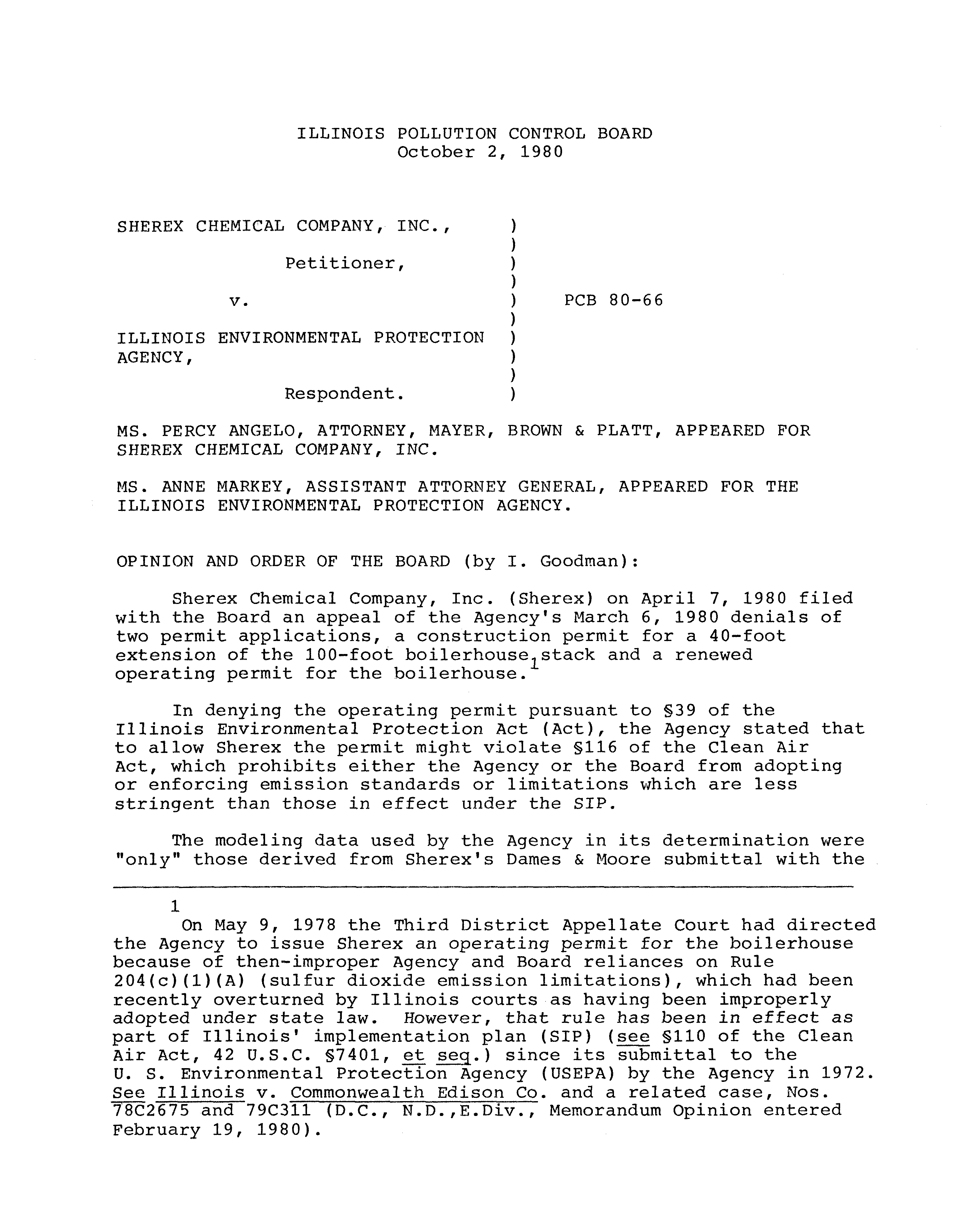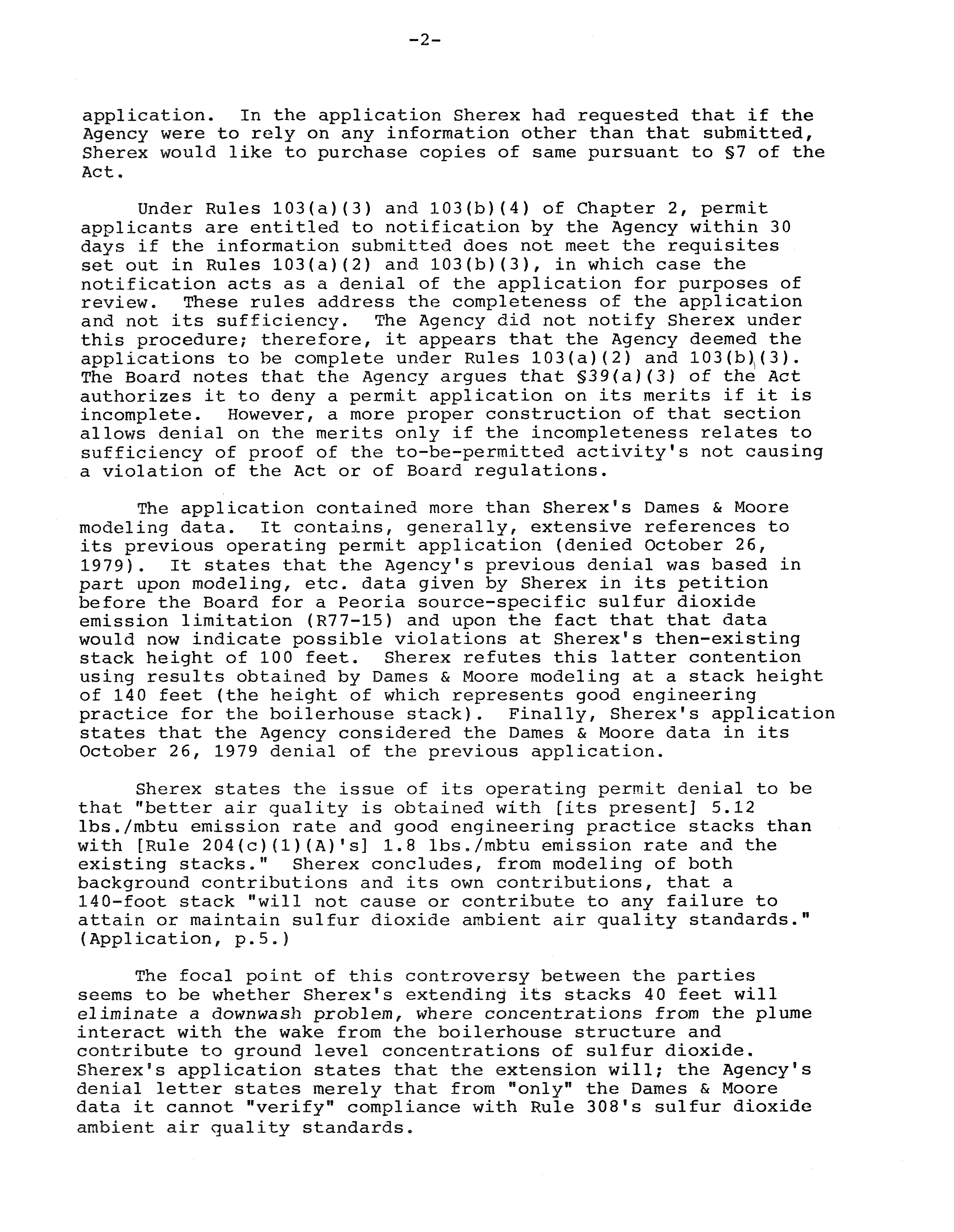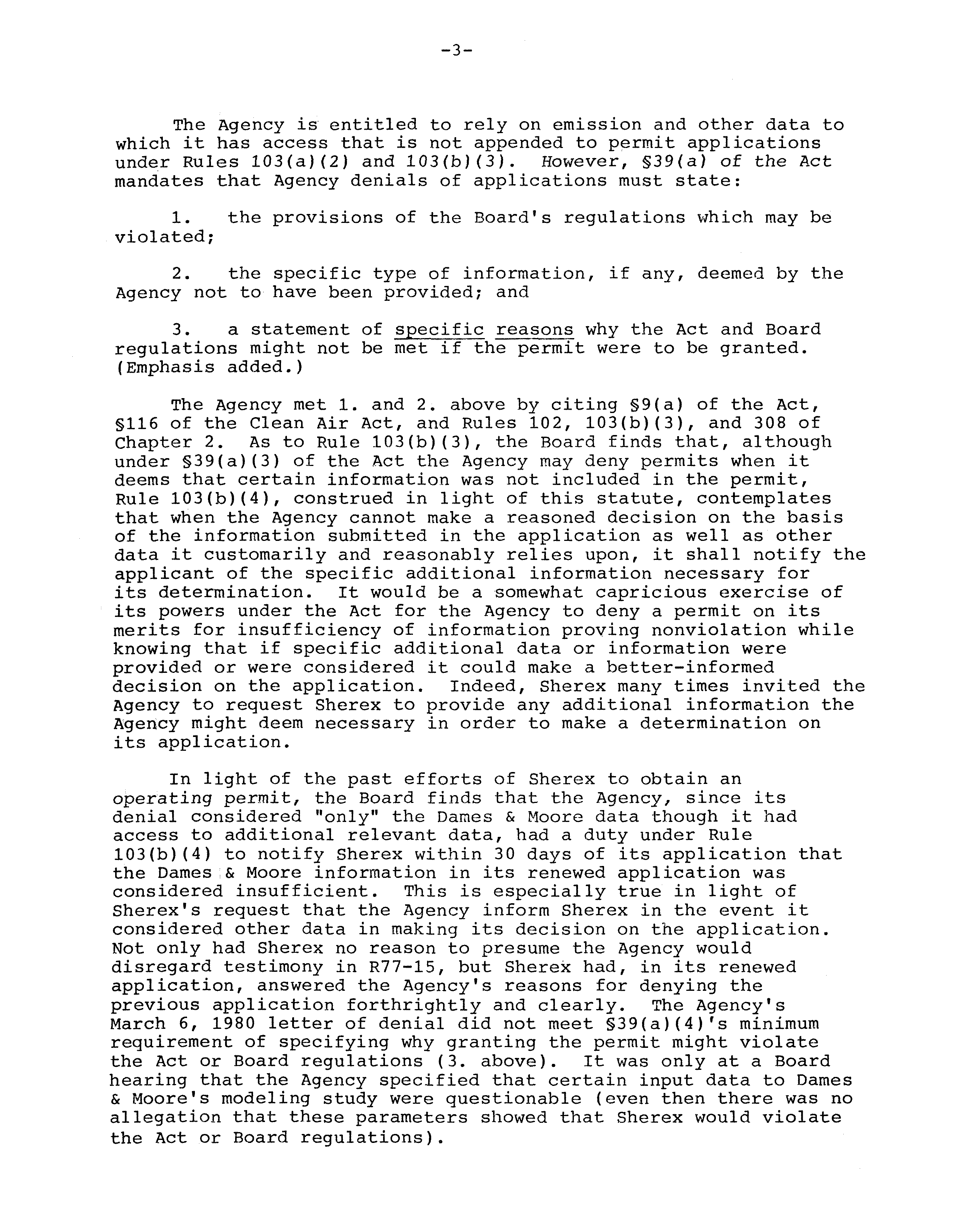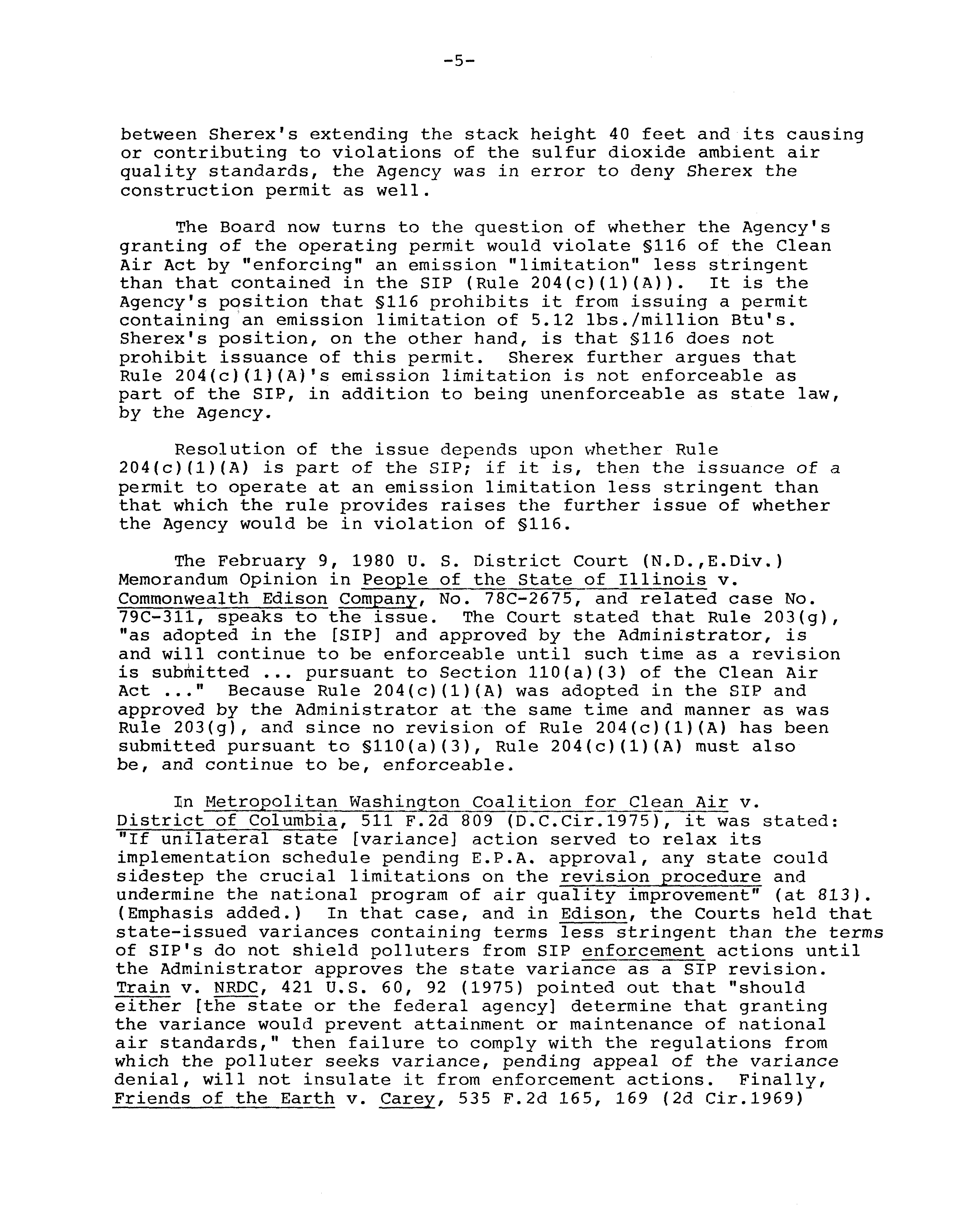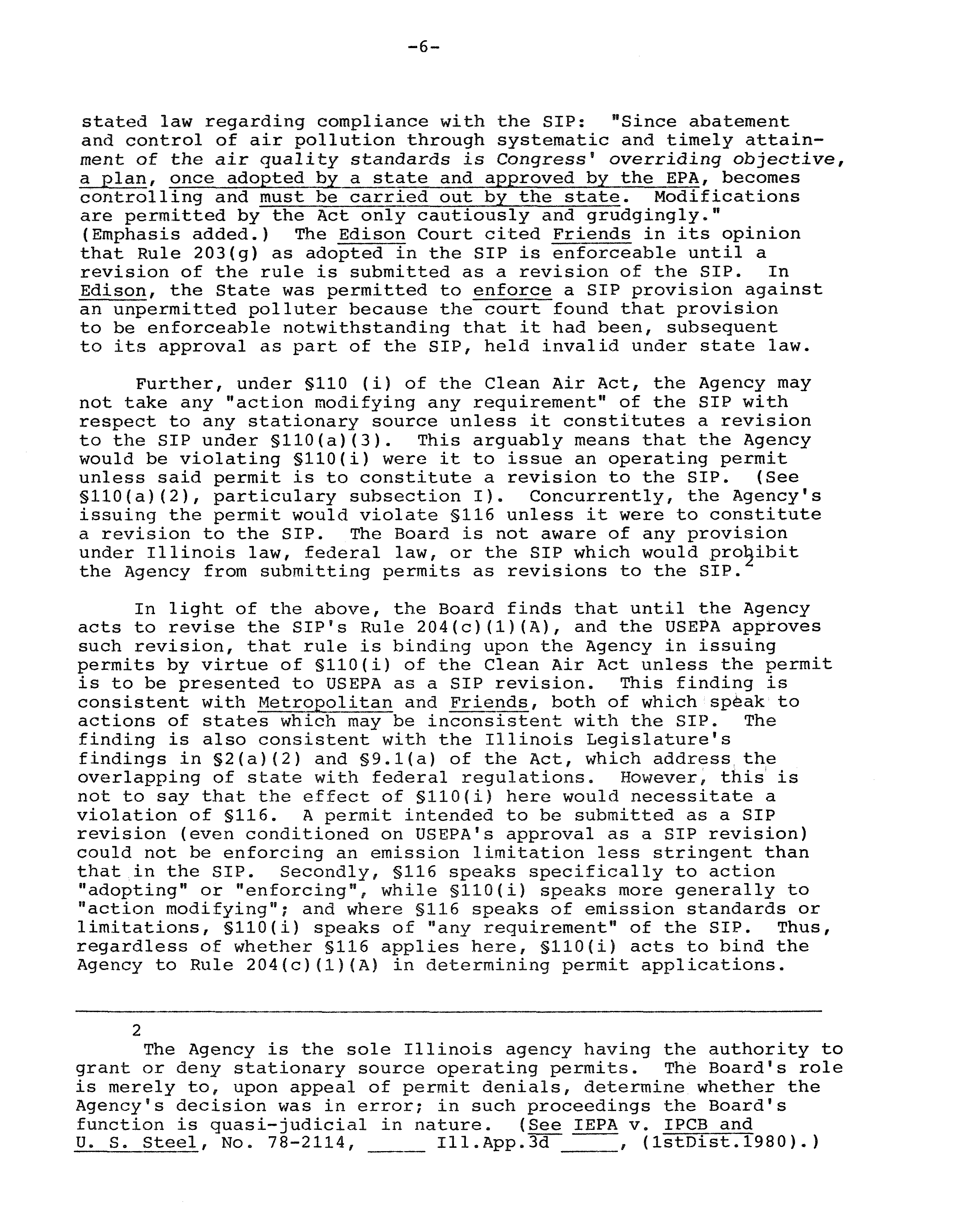ILLINOIS POLLUTION CONTROL BOARD
October
2,
1980
SHEREX CHEMICAL COMPANY,
INC.,
)
Petitioner,
v.
)
PCB 80—66
ILLINOIS ENVIRONMENTAL PROTECTION
)
AGENCY,
Respondent.
MS. PERCY ANGELO, ATTORNEY,
MAYER, BROWN & PLATT, APPEARED FOR
SHEREX CHEMICAL COMPANY, INC.
MS.
ANNE
MARKEY, ASSISTANT ATTORNEY GENERAL, APPEARED FOR THE
ILLINOIS ENVIRONMENTAL PROTECTION AGENCY.
OPINION AND ORDER OF THE BOARD
(by I. Goodman):
Sherex Chemical Company,
Inc.
(Sherex)
on April
7,
1980 filed
with the Board an appeal of the Agency’s March
6,
1980 denials of
two permit applications, a construction permit for a 40—foot
extension of the 100—foot boilerhouse1stack and a renewed
operating permit for the boilerhouse.
In denying the operating permit pursuant to §39 of the
Illinois Environmental Protection Act
(Act), the Agency stated that
to allow Sherex the permit might violate §116 of the Clean Air
Act, which prohibits either the Agency or the Board from adopting
or enforcing emission standards
or limitations which are less
stringent than those in effect under the
SIP.
The modeling data used by the Agency in its determination were
“only” those derived from Sherex’s Dames
& Moore submittal with the
1
On May 9,
1978 the Third District Appellate Court had directed
the Agency to issue Sherex an operating permit for the boilerhouse
because of then—improper Agency and Board reliances on Rule
204(c)(1)(A)
(sulfur dioxide emission limitations), which had been
recently overturned by Illinois courts as having been improperly
adopted under state law.
However,
that rule has been in effect as
part of Illinois’
implementation plan
(SIP)
(see §110 of the Clean
Air Act,
42 U.S.C. §7401, et ~q.)
since its submittal
to the
U.
S.
Environmental Protection Agency (USEPA) by the Agency in 1972.
See Illinois v.
Commonwealth Edison Co. and a related case,
Nos.
7~2675 and 79C311
(D.C., N.D.,E.Div.,
Memorandum Opinion entered
February 19,
1980).
—2—
application.
In
the
application
Sherex
had
requested
that
if
the
Agency
were
to
rely
on
any
information
other
than
that
submitted,
Sherex
would
like
to
purchase
copies
of
same
pursuant
to
57
of
the
Act.
Under Rules 103(a)(3) and 103(b)(4) of chapter 2,
permit
applicants are entitled to notification by the
Agency
within 30
days if the information submitted does
not
meet the requisites
set out in Rules 103(a)(2) and 103(b)(3), in which case the
notification acts as a denial of the application for purposes of
review.
These rules address the completeness of the application
and
not its lufficiency.
The Agency did not notify Sherex under
this procedure; therefore, it appears that the
Agency deemed
the
applications to be complete under Rules 103(a)(2) and 103(b)~(3).
The Board notes that the Agency argues that 539(a) (3) of the
Act
authorizes it to deny a permit application on its merits if it is
incomplete.
However, a more proper construction of that section
allows denial on the merits only if the incompleteness relates to
sufficiency of proof of the to-be-permitted activity’s not causing
a violation of the
Act
or of Board regulations.
The application contained more than Sherex’s Dames & Moore
modeling data.
It contains, generally, extensive references to
its previous operating permit application (denied October 26,
1979).
It states that the Agency’s previous denial was based in
part upon modeling, etc. data given by Sherex in its petition
before the Board for a Peoria source—specific sulfur dioxide
emission limitation (R77—15) and upon the fact that
that
data
would
now
indicate possible violations at Sherex’s then—existing
stack height of 100 feet.
Sherex
refutes this latter contention
using results obtained by Dames & Moore modeling at a stack height
of 140 feet
(the height of which represents good engineering
practice for the boilerhouse stack).
Finally,
Sherex’s application
states that the Agency considered the Dames & Moore data in its
October 26, 1979 denial of the previous application.
Sherex
states the issue of its operating permit denial to be
that ‘better air quality is obtained with (its present) 5.12
lbs./mbtu emission rate and
good
engineering practice stacks than
with Rule
204(c)(1)(A)’s
1.8 lbs./mbtu emission rate and the
existing stacks.’
Sherex
concludes, from modeling of
both
background contributions and its own contributions, that a
140—foot stack ‘will not cause or contribute to any failure to
attain or maintain sulfur dioxide ambient air quality standards.’
(Application, p.5.)
The focal point of this controversy between the parties
seems to be whether Sherex’s extendin9 its stacks 40 feet will
eliminate
a
downwash
problem,
where concentrations from the plume
interact
with
the
wake
from
the
boilerhouse
structure
and
contribute
to
ground
level
concentrations
of
sulfur
dioxide.
Sherex’s
application
states
that
the
extension
will;
the
Agency’s
denial
letter
states
merely
that
from
‘only’
the
Dames
&
Moore
data
it
cannot
‘verify’
compliance
with
Rule
308’s
sulfur
dioxide
ambient
air
quality
standards.
—3—
The Agency is entitled to rely on emission and other data to
which it has access that is not appended to permit applications
under Rules 103(a) (2) and 103(b)(3).
However,
§39(a)
of the Act
mandates that Agency denials of applications must state:
1.
the provisions of the Board’s regulations which may be
violated;
2.
the specific type of information,
if any, deemed by the
Agency not to have been provided; and
3.
a statement of ~
reasons why the Act and Board
regulations might not be met if the permit were to be granted.
(Emphasis added.)
The Agency met 1.
and
2.
above by citing §9(a) of the Act,
§116 of the Clean Air Act,
and Rules
102,
103(b)(3),
and 308 of
Chapter
2.
As to Rule 103(b)(3), the Board finds that, although
under §39(a)(3) of the Act the Agency may deny permits when it
deems that certain information was not included in the permit,
Rule 103(b)(4), construed in light of this statute, contemplates
that when the Agency cannot make
a reasoned decision on the basis
of the information submitted in the application as well as other
data it customarily and reasonably relies upon,
it shall notify the
applicant of the specific additional information necessary for
its determination.
It would be a somewhat capricious exercise of
its powers under the Act for the Agency to deny a permit on its
merits for insufficiency of information proving nonviolation while
knowing that
if specific additional data or information were
provided or were considered it could make a better—informed
decision on the application.
Indeed,
Sherex many times invited the
Agency to request Sherex to provide any additional information the
Agency might deem necessary in order to make a determination on
its application.
In light of the past efforts of Sherex to obtain an
operating permit,
the Board finds that the Agency,
since its
denial considered “only”
the Dames
& Moore data though it had
access to additional relevant data, had a duty under Rule
103(b)(4) to notify Sherex within 30 days of its application that
the Dames& Moore information in its renewed application was
considered insufficient.
This
is especially true in light of
Sherex’s request that the Agency inform Sherex in the event it
considered other data in making its decision on the application.
Not only had Sherex no reason to presume the Agency would
disregard testimony in R77-15, but Sherex had,
in its renewed
application, answered the Agency’s reasons for denying the
previous application forthrightly and clearly.
The Agency’s
March
6,
1980 letter of denial did not meet §39(a)(4)’s minimum
requirement of specifying why granting the permit might violate
the Act or Board regulations
(3.
above).
It was only at a Board
hearing that the Agency specified that certain input data to Dames
& Moore’s modeling study were questionable
(even then there was no
allegation that these parameters showed that Sherex would violate
the Act or Board regulations).
—4--
From a reading of the record, the Board cannot ascertain why
granting this operating permit would violate Rule 308’s sulfur
dioxide air quality standards.
The evidence presented
shows
that
Sherex’s emissions
(5.12 lbs./M Btu’s), combined with Peoria
area background co~centrations,show a maximum 3—hour concentra-
tion of 507.1 ug/m
wher~asthe secondary standard is more than
twice that (1,300.0 ug!m
).
(Ex.1,p.5).
Sherex’s modeling,
using
the applied—for, 140—foot stack height at a rate of 5.12 lbs.!
M Btu’s,
shows its contribution t~the maximum 3—hour
concentrations will be 502.0 ug!m
.
Using its present 100—foot
stack height,
but at Rule 204(c)(1)(A)’s emission rate of 1.8
lbs.3 its contribution should under present conditions be 625.0
ug/m
.
(Ex.1,p.4)
Thus,
Sherex argues,
issuance of the stack
construction permit simultaneously with the boilerhouse operating
permit will decrease its present contribution to the secondary
air quality standard, which contribution does not cause the
1,300,0 ug/m
standard to be violated in the Peoria area.
It is
apparent that the Agency considered both the construction and the
operation permit applications in tandem.
It apparently decided,
since the application was otherwise deemed complete, that to
allow a rate of 5.12 lbs../million Btu’s at a stack height of 140
feet
would cause or contribute to violations of the Act or the
Board’ s regulations.
Modeling data using Sherex’s present rate, whether with or
without the applied-for stack height extension,
show no contribu-
tions to violations of the ambient air quality standards for sulfur
dioxide.
Therefore,
the Agency’s denials of both the operating
permit and the stack construction permit were wrong and are hereby
overturned.
This the Board determines from modeling data in the
record, which because of the Agency’s denial
letter, theoretically
included “only” the Dames
& Moore results,
but which in point of
fact included all prior permit application considerations.
This is
true,
despite the provision in Rules 103(a)(2) and 103(b)(3) that
information contained in previous applications must be certified
by the applicant as remaining correct, because the Agency had
access to that information, because
it
was alerted to
it by
Sherex’s rebuttal references to the October,
1979 denial of the
previous application, and because the previous permit denial
record was incorporated into this record.
This time around,
Sherex sought the operating permit along with a permit for
construction of the stack extension.
Under Rule 103(a)(1),
a construction permit is necessary
because the boilerhouse stack is an existing emission source
which would be modified were it to be extended by 40 feet.
This
is true, contrary to Sherex’s assertion, whether “modifications”
under that rule would increase or would decrease ambient air
quality levels,
Also contrary to Sherex’s assertion,
stack heights
can relate to compliance with sulfur dioxide emission limitations
for
purposes of enforcement actions as well as for permit issuance
because they affect the location at which pollutants are concentrated.
However, as the Agency record before us shows no relationship
—5-.
between Sherex’s extending the stack height 40 feet and its causing
or contributing to violations of the sulfur dioxide ambient air
quality standards,
the Agency was in error to deny Sherex the
construction permit as well.
The Board now turns to the question of whether the Agency’s
granting of the operating permit would violate §116 of the Clean
Air Act by “enforcing” an emission “limitation”
less stringent
than that contained in the SIP (Rule 204(c)(1)(A)).
It is the
Agency’s position that §116 prohibits
it from issuing a permit
containing an emission limitation of 5.12 lbs./million Btu’s.
Sherex’s position, on the other hand,
is that §116 does not
prohibit issuance of this permit.
Sherex further argues that
Rule 204(c)(1)(A)’s emission limitation is not enforceable as
part of the SIP,
in addition to being unenforceable as state law,
by the Agency.
Resolution of the issue depends upon whether Rule
204(c)(1)(A)
is part of the SIP;
if it
is,
then the issuance of a
permit to operate at an emission limitation less stringent than
that which the rule provides raises
the further issue of whether
the Agency would be in violation of §116.
The February
9,
1980
U.
S.
District Court
(N.D.,E.Div.)
Memorandum Opinion in People of the State of Illinois v.
Commonwealth Edison Company,
No.
78C-2675, and related case No.
79C-311,
speaks to the issue.
The Court stated that Rule 203(g),
“as adopted in the
SIP
and approved by the Administrator,
is
and will continue to be enforceable until such time as a revision
is submitted
...
pursuant to Section 110(a)(3) of the Clean Air
Act
...“
Because Rule 204(c)(1)(A) was adopted in the SIP and
approved by the Administrator at the same time and manner as was
Rule 203(g), and since no revision of Rule 204(c)(1)(A) has been
submitted pursuant to §110(a)(3), Rule 204(c)(1)(A) must also
be, and continue to be, enforceable.
in MetrQpolitan Washington Coalition for Clean Air
V.
District of Columbia, 511 F.2d 809
(D.C.Cir.1975),
it was stated:
“If unilateral state
variance
action served to relax its
implementation schedule pending E.P.A. approval,
any state could
sidestep the crucial
limitations on the revision procedure and
undermine the national program of air quality improvement”
(at 813).
(Emphasis added.)
In that case,
and in Edison,
the Courts held that
state-issued variances containing terms less stringent than the terms
of SIP’s do not shield polluters from SIP enforcement actions until
the Administrator approves the state variance as a SIP revision.
Train v. NRDC,
421 U.S.
60,
92
(1975) pointed out that “should
either
the
state or the federal agency)
determine that granting
the variance would prevent attainment or maintenance of national
air standards,” then failure to comply with the regulations from
which the polluter seeks variance, pending appeal of the variance
denial, will not insulate it from enforcement actions.
Finally,
Friends of the Earth v.
Carey,
535 F.2d 165, 169
(2d Cir.1969)
—6—
stated law regarding compliance with the SIP:
“Since abatement
and control of air pollution through systematic and timely attain-
ment of the air quality standards is Congress’ overriding objective,
once adopted by a state and approved by the EPA, becomes
controlling and must be carried out by the state.
Modifications
are permitted by the Act only cautiously and grudgingly.”
(Emphasis added.)
The Edison Court cited Friends in its opinion
that Rule 203(g)
as adopted in the SIP is enforceable until
a
revision of the rule is submitted as a revision of the SIP.
In
Edison,
the State was permitted to enforce a SIP provision against
an unpermitted polluter because the court found that provision
to be enforceable notwithstanding that it had been,
subsequent
to its approval as part of the SIP, held invalid under state
law.
Further, under §110
(i)
of the Clean Air Act,
the Agency may
not take any “action modifying any requirement” of the SIP with
respect to any stationary source unless it constitutes a revision
to the SIP under §110(a)(3).
This arguably means that the Agency
would be violating §110(i) were it to issue an operating permit
unless said permit is to constitute a revision to the SIP.
(See
§110(a) (2), particulary subsection I).
Concurrently,
the Agency’s
issuing the permit would violate §116 unless it were to constitute
a revision to the SIP.
The Board is not aware of any provision
under Illinois law, federal
law, or the SIP which would proI~ibit
the Agency from submitting permits as revisions to the SIP.
In light of the above, the Board finds that until the Agency
acts to revise the SIP’s
Rule 204(c)(1)(A), and the USEPA apptoves
such revision, that rule is binding upon the Agency in issuing
permits by virtue of §110(i) of the Clean Air Act unless the permit
is to be presented to USEPA as a SIP revision,
This finding is
consistent with Metropolitan and Friends, both of which speak to
actions of states which may be inconsistent with the SIP.
The
finding
is also consistent with the Illinois Legislature’s
findings in §2(a)(2) and §9.1(a) of the Act, which address the
overlapping of state with federal regulations.
However, this
is
not to say that the effect of §110(1) here would necessitate a
violation of §116.
A permit intended to be submitted as a SIP
revision (even conditioned on USEPA’s approval as a SIP revision)
could not be enforcing an emission limitation less stringent than
that in the SIP.
Secondly, §116 speaks specifically to action
“adopting” or “enforcing”, while §110(i)
speaks more generally to
“action modifying”;
and where §116 speaks of emission standards or
limitations, §110(i)
speaks of “any requirement” of the SIP.
Thus,
regardless of whether §116 applies here, §110(i) acts to bind the
Agency to Rule 204(c)(1)(A)
in determining permit applications.
2
The Agency is the sole Illinois agency having the authority to
grant or deny stationary source operating permits.
The Board’s role
is merely to, upon appeal of permit denials, determine whether the
Agency’s decision was in error;
in such proceedings the Board’s
function is quasi—judicial
in nature.
(See IEPA v.
IPCB and
U.
S.
Steel,
No.
78—2114,
Ill.App.3d
_____
,
(lstDist.1980).)
—7--
However, §116 does seem inapplicable, given §110(i)’s binding effect,
when the Agency action in intended for submittal as a SIP revision.
The Board finds that the record shows that Sherex would not
violate Rule 308 and that the Agency can properly issue the permit.
The Board further finds that neither §110(i) nor §116 prevents the
Agency from determining the merits of a permit application in
accordance with state
law, regardless of related or conflicting
SIP provisions,
under its powers under the Act.
However,
a permit
issqed without subsequent acceptance as
a SIP revision does not
shield the pérmittee from enforcement actions under §304(f) of the
Clean Air Act.
This Opinion constitutes the findings of fact and
conclusions of law of the Board in this matter.
ORDER
The Illinois Environmental Protection Agency’s March
6,
1980
denials of Sherex Chemical Company, Inc.’s construction permit
application (C912017) and operating permit application
(D03032131) are reversed.
The permit applications are remanded to the Agency for
reconsideration in light of this Opinion.
IT IS SO ORDERED.
Mrs. Anderson concurs.
I,
Christan
L.
Moffett, Clerk of the Illinois Pollution
Control Board, hereby ce~tifythat the above Opinion and Order
were adopted on the
~
day of
_______________,
1980
by a vote
of
çJj.
Christan
L. Moffet~/Cler/
Illinois Pollution Control Board
